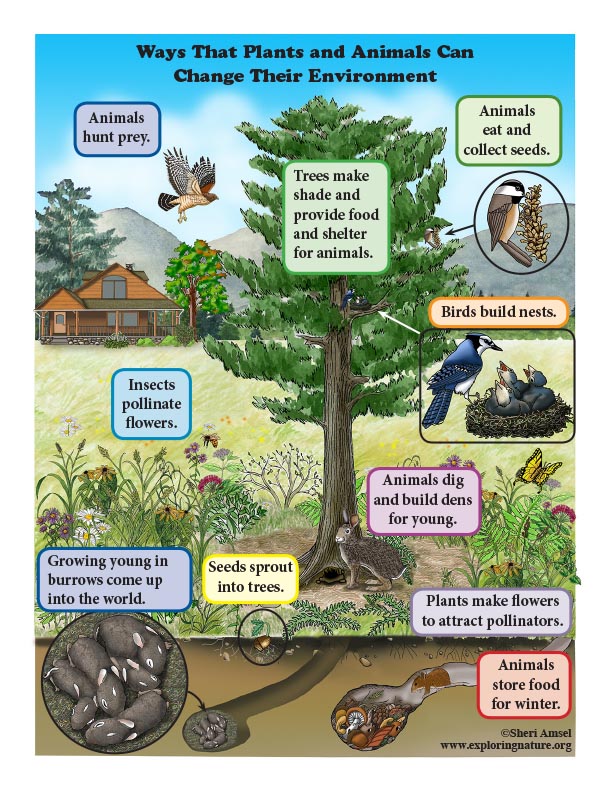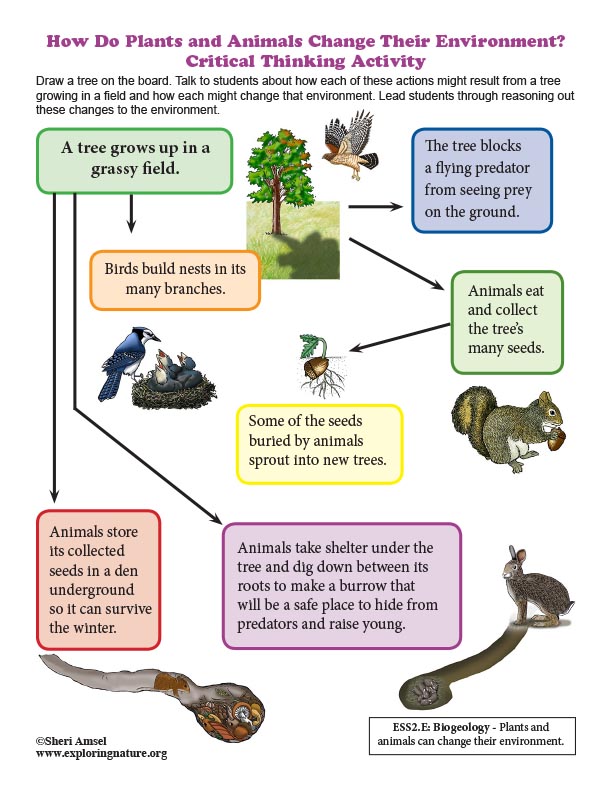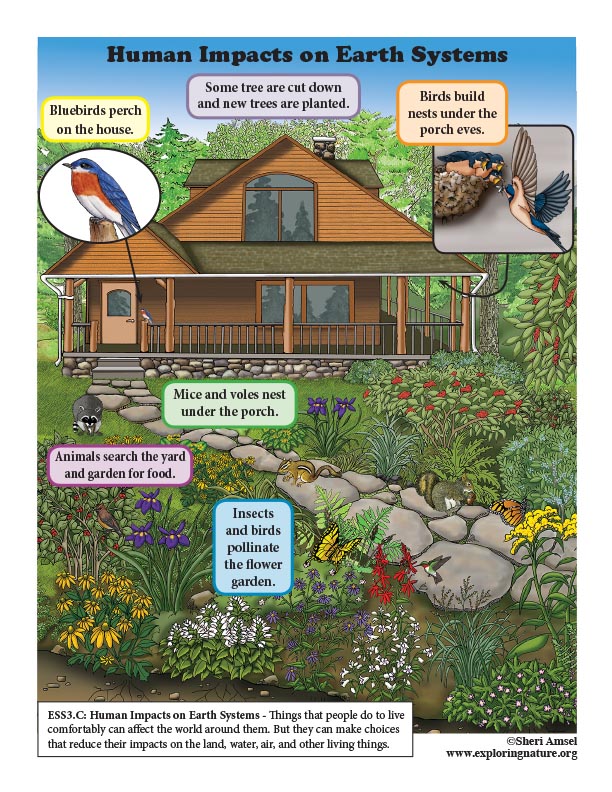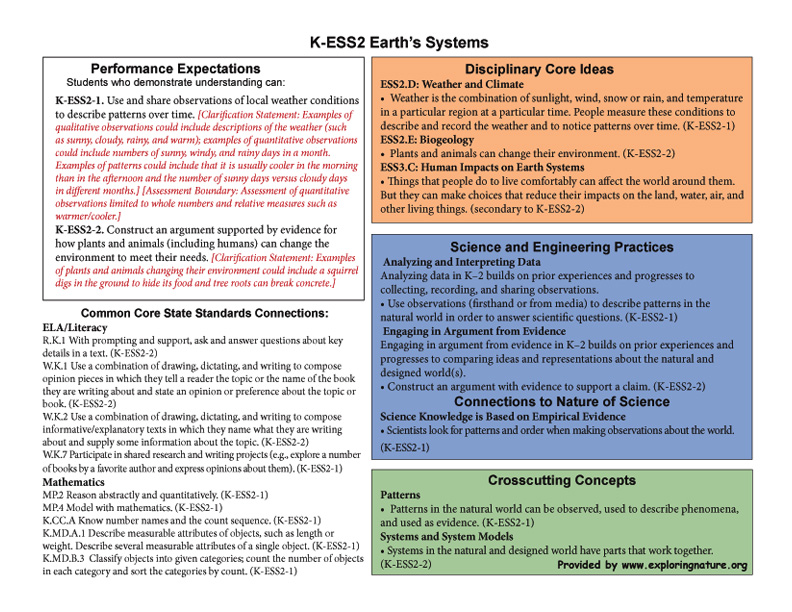

_________________________________________________________________________________________________________________________________________________________
Disciplinary Core Ideas
ESS2.D: Weather and Climate
• Weather is the combination of sunlight, wind, snow or rain, and temperature in a particular region at a particular time. People measure these conditions to describe and record the weather and to notice patterns over time. (K-ESS2-1)
ESS2.E: Biogeology
• Plants and animals can change their environment. (K-ESS2-2)
ESS3.C: Human Impacts on Earth Systems
• Things that people do to live comfortably can affect the world around them. But they can make choices that reduce their impacts on the land, water, air, and other living things. (secondary to K-ESS2-2)
Performance Expectations Students who demonstrate understanding can:
K-ESS2-1. Use and share observations of local weather conditions to describe patterns over time. [Clarification Statement: Examples of qualitative observations could include descriptions of the weather (such as sunny, cloudy, rainy, and warm); examples of quantitative observations could include numbers of sunny, windy, and rainy days in a month. Examples of patterns could include that it is usually cooler in the morning than in the afternoon and the number of sunny days versus cloudy days in different months.] [Assessment Boundary: Assessment of quantitative observations limited to whole numbers and relative measures such as warmer/cooler.]
K-ESS2-2. Construct an argument supported by evidence for how plants and animals (including humans) can change the environment to meet their needs. [Clarification Statement: Examples of plants and animals changing their environment could include a squirrel digs in the ground to hide its food and tree roots can break concrete.]
_________________________________________________________________________________________________________________________________________________________
Use the Template and Resource Links to Fulfill NGSS
l. Goals:
Essential Questions:
NGSS Note: Think, question, entertain ideas.
ll. Introductory Activities to Assess Prior Knowledge
ESS2.D: Weather and Climate
A. Simple Activities - that assess students’ understanding of weather patterns.
Seasons: Print-Copy-Cut-Paste
Weather – Matching
C. Brainstorming Session
Question: What are some weather patterns vs. climates you know about?
1. Break students down into groups of 3-4.
2. Ask students to generate a list of the different weather patterns vs. climates they know of and briefly decribe them.
3. Discuss
ESS2.E: Biogeology
A. Simple Activities - that assess students’ understanding of how plants and animals can change their environment.
Plants and Animals and Their Environment - Matching
ESS3.C: Human Impacts on Earth Systems
How Do Humans Affect Their Environment? Critical Thinking
ESS2.D: Weather and Climate
A. For this age, a reading assignment is not appropriate for introducing new content. We suggest collecting picture books that depict weather and reading them to the class. Then discussing the content. To assess what they learned from these books (kindergarten version of Vocabulary Assessment and Reading Comprehension Assessment) by doing a weather activity.
B. Introduce a Model that depicts the concept expressed in the lesson (students should begin to think about their own model building – for this age, perhaps, a weather diorama or poster).
Weather Cut and Paste
Weather Coloring Page
C. Read to your students about weather and environmental issues.
Weather and Seasons
Global Warming and Climate Change
Changing Seasons
Environmental Issues
Seasonal Posters - Winter, Spring, Summer, Fall
Storms - Hurricanes
Storms - Thunderstorms
Storms - Tornadoes
Examples of Models (depicts the concept expressed in the reading): Ask students to look at photos and illustrations of weather phenomenon (and environmental issues) and ask them questions to test if they've picked up knowledge.
ESS2.E: Biogeology
How Plants and Animals Affect the Environment (Kindergarten) - Reading and Poster
Ways That Plants and Animals Change Their Environment - Coloring Page
Ways That Plants and Animals Can Change Their Environment - Diagrams
ESS3.C: Human Impacts on Earth Systems
Human Impacts on Earth Systems - Poster
Humans Affect Earth Systems - Coloring Page
Examples of Models (depicts the concept expressed in the reading):
Ask students to look at the models of and explain how each illustrates the concept.
Inquiry related to Earth's weather and climate:
Rain-making Experiment
Cloud-making Experiment
Smog Alert! Activity - What Conditions Cause Smog to Form?
ESS2.E: Biogeology
How Do Plants and Animals Change Their Environment? Critical Thinking Activity
ESS3.C: Human Impacts on Earth Systems
How Do Humans Affect Their Environment? Critical Thinking
Humans Affect Their Environment - Poster Making Activity
V. Summarize Knowledge - Enduring Understandings
Disciplinary Core Ideas
ESS2.D: Weather and Climate
• Weather is the combination of sunlight, wind, snow or rain, and temperature in a particular region at a particular time. People measure these conditions to describe and record the weather and to notice patterns over time. (K-ESS2-1)
ESS2.E: Biogeology
• Plants and animals can change their environment. (K-ESS2-2)
ESS3.C: Human Impacts on Earth Systems
• Things that people do to live comfortably can affect the world around them. But they can make choices that reduce their impacts on the land, water, air, and other living things. (secondary to K-ESS2-2)
Science and Engineering Practices (NGSS)
Analyzing and Interpreting Data
Analyzing data in K–2 builds on prior experiences and progresses to collecting, recording, and sharing observations.
• Use observations (firsthand or from media) to describe patterns in the natural world in order to answer scientific questions. (K-ESS2-1)
Engaging in Argument from Evidence
Engaging in argument from evidence in K–2 builds on prior experiences and progresses to comparing ideas and representations about the natural and designed world(s).
• Construct an argument with evidence to support a claim. (K-ESS2-2)
Connections to Nature of Science
Science Knowledge is Based on Empirical Evidence
• Scientists look for patterns and order when making observations about the world. (K-ESS2-1)
Crosscutting Concepts (NGSS)
Patterns
• Patterns in the natural world can be observed, used to describe phenomena, and used as evidence. (K-ESS2-1)
Systems and System Models
• Systems in the natural and designed world have parts that work together. (K-ESS2-2)
Performance Expectations
Students who demonstrate understanding can:
K-ESS2-1. Use and share observations of local weather conditions to describe patterns over time. [Clarification Statement: Examples of qualitative observations could include descriptions of the weather (such as sunny, cloudy, rainy, and warm); examples of quantitative observations could include numbers of sunny, windy, and rainy days in a month. Examples of patterns could include that it is usually cooler in the morning than in the afternoon and the number of sunny days versus cloudy days in different months.] [Assessment Boundary: Assessment of quantitative observations limited to whole numbers and relative measures such as warmer/cooler.]
K-ESS2-2. Construct an argument supported by evidence for how plants and animals (including humans) can change the environment to meet their needs. [Clarification Statement: Examples of plants and animals changing their environment could include a squirrel digs in the ground to hide its food and tree roots can break concrete.]
Common Core State Standards Connections
ELA/Literacy
R.K.1 With prompting and support, ask and answer questions about key details in a text. (K-ESS2-2)
W.K.1 Use a combination of drawing, dictating, and writing to compose opinion pieces in which they tell a reader the topic or the name of the book they are writing about and state an opinion or preference about the topic or book. (K-ESS2-2)
W.K.2 Use a combination of drawing, dictating, and writing to compose informative/explanatory texts in which they name what they are writing about and supply some information about the topic. (K-ESS2-2)
W.K.7 Participate in shared research and writing projects (e.g., explore a number of books by a favorite author and express opinions about them). (K-ESS2-1)
Mathematics -
MP.2 Reason abstractly and quantitatively. (K-ESS2-1)
MP.4 Model with mathematics. (K-ESS2-1)
K.CC.A Know number names and the count sequence. (K-ESS2-1)
K.MD.A.1 Describe measurable attributes of objects, such as length or weight. Describe several measurable attributes of a single object. (K-ESS2-1)
K.MD.B.3 Classify objects into given categories; count the number of objects in each category and sort the categories by count. (K-ESS2-1)
When you research information you must cite the reference. Citing for websites is different from citing from books, magazines and periodicals. The style of citing shown here is from the MLA Style Citations (Modern Language Association).
When citing a WEBSITE the general format is as follows.
Author Last Name, First Name(s). "Title: Subtitle of Part of Web Page, if appropriate." Title: Subtitle: Section of Page if appropriate. Sponsoring/Publishing Agency, If Given. Additional significant descriptive information. Date of Electronic Publication or other Date, such as Last Updated. Day Month Year of access < URL >.
Amsel, Sheri. "Kindergarten - K-ESS2 Earth's Systems" Exploring Nature Educational Resource ©2005-2024. April 4, 2024
< http://www.exploringnature.org/db/view/1976 >




